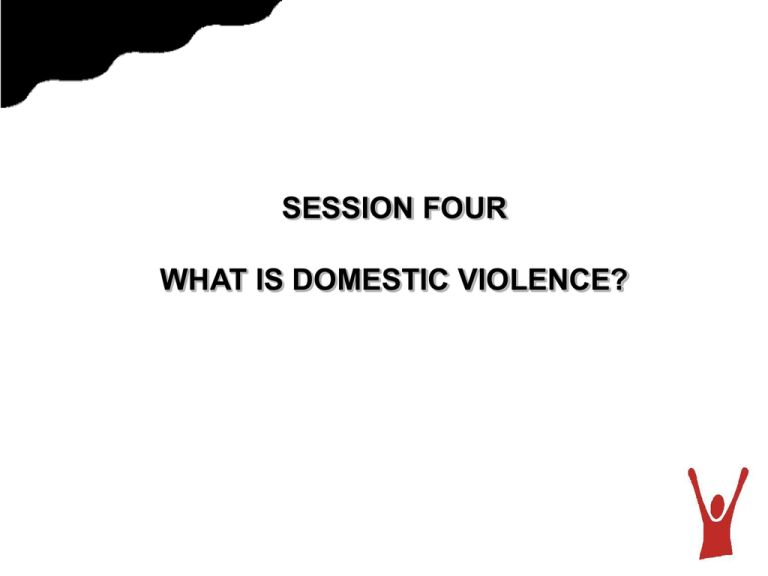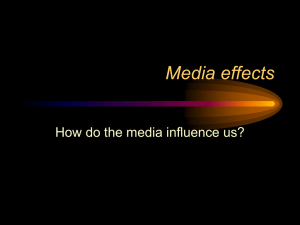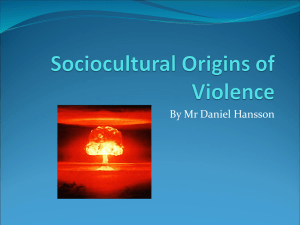
SESSION FOUR
WHAT IS DOMESTIC VIOLENCE?
Defining Domestic and
Family Violence
Domestic
And Family Violence
is an abuse of power
perpetrated mainly (but
not only) by men against
women in a relationship or
after separation. It occurs
when one partner attempts to
physically and/or
psychologically dominate and
control the other.
26
What is Domestic Violence?
Physical abuse:
Kicking, slapping, hitting, punching, pushing, pulling,
choking and property damage.
Emotional abuse:
Jealously, anger, intimidation, controlling, neglect,
humiliation,threats, isolation and verbal abuse.
Social Abuse:
Being stopped from meeting or seeing friends or family,
not allowed to leave the home. Being stalked.
Sexual abuse:
Forcing and coercing sexual acts, rape and having sex
without wanting to.
Economic Abuse:
Controlling access to money and other resources, forced
to live without money.
27
Myths & Facts
Myth
28
Fact
Domestic and Family violence only
occurs in working or poorer families
Domestic and family violence
happens in all communities, from all
social and cultural groupings.
Violent men cannot control
themselves, their behaviour is “out
of their control”
This is not true. If men cannot
control their violent behaviours then
they would try to dominate and
control everybody including their
bosses, their work friends and all
other people they come into contact
with.
Women enjoy being abused,
otherwise they would leave the
situation
There are many reasons why women
do not leave violent situations. They
fear social isolation, community
stigma and financial problems. Also
after long-term abuse, their self
esteem is very low and they do not
have the support systems to build
their confidence.
Myths & Facts
Myth
29
Fact
Loving caring partners do not use
violence
Violence can happen even in the
most loving and caring relationships.
Only small numbers of women have
experienced domestic & family
violence
International and Australian studies
undertaken in hospitals, by the police ,
by some churches and by community
services all suggest that one in three to
five women will experience domestic &
family violence.
Alcohol and stress are to blame for
domestic violence.
Alcohol and stress are not an excuse
for domestic violence, it only acts as a
excuse. It is up to the person who
commits domestic violence to accept
responsibility.
Myths & Facts
Myth
30
Fact
Domestic Violence is rarely spoken
about, it is a private family matter.
Domestic violence is a crime. It is not
part of any relationship.
Domestic violence if hidden can
escalate and do more damage if no one
knows about it.
Domestic violence only happens where
there is unemployment and poverty in
the family
Women from all backgrounds, all ages,
all cultures, employed and unemployed
are likely to be victims of domestic
violence
Women know their rights and can leave
the situation if they want to.
A strong sense of silence and secrecy
often go with Domestic Violence.
Women fear speaking out. The violence
causes low self-esteem and no one
wants their family to break up. Most
women hope the violence will stop.
Some women provoke violence and
they are part of the problem
No family deserves violence, dealing
with problems in ways that don’t
involve violence is the key, not blaming
the victim.
Commonly named causes or
excuses for domestic violence
Financial pressure on the family
causing stress
Drug & alcohol abuse by one or more
family members
Gambling by either partner
Abuse within extended families, generational
abuse
Typical and acceptable “male” behaviour
Culturally acceptable behaviour
31
Indicators of domestic and family
violence, experienced by women
Physical injuries, including broken bones, no
explanation for injuries
Threats to safety, intimidation or harassment
Current or previous police involvements
Feelings of sadness or depression, low self
esteem
Difficulty in concentration or focus
Being denied access to funds or resources and/or
repeated requests for financial assistance
32
Indicators of domestic and family
violence, experienced by women
Over protective of children and avoidance of
discussing children
Current or previous separation in the relationship
Extensive use of medications
Lack of self esteem or self confidence
Problems with sleep & sleeplessness
Nervous or withdrawn behaviours
33
Indicators of domestic and family
violence, experienced by women
Aggressive behaviours or language
Isolation from friends, family & community
Medical or psychosomatic illness, such as
headaches or stomach problems, frequent visits
to hospital or doctor
Eating disorders
Difficulty with friendships
34
Impacts of domestic and family
violence on children and young people
Physical injuries
Bed wetting or soiling
Psychosomatic illness
Behavioural problems
Anxious or fearful behaviours
Aggressive language or behaviours
Developmental delays
Nervous or withdrawn behaviours
35
Impacts of domestic and family
violence on children and young people
Advanced maturity, sense of responsibility
Disturbed sleep, nightmares, constant waking,
fear of the dark
Use of drugs or alcohol
Difficulty forming and maintaining relationships,
poor social skills.
Lacking in confidence, poor self esteem and
self image
Sadness or depression
Eating disorders
Self-harming behaviours
36
Some Additional Causal Factors
Experienced By Migrant Communities
Financial pressure: in particular the financial pressure of supporting relatives in the
home country and the pressure of unemployment
Gambling
Changes in women’s attitudes, expectation and roles.
Relationship difficulties, including issues relating to children, which were seen to
put pressure on relationships that may lead to domestic violence
Male behaviours and attitudes in particular in response to the changed roles of
women in Australia
Cultural differences, in the context of mixed marriages
Provocation from women experiencing the freedom of women's rights
37
Issues which impact on the
incidence of domestic violence
in refugee communities
Pre arrival torture, trauma, rape and sexual violence
Post traumatic stress disorder
Problems experienced during resettlement
Racism
Loss of dreams
Loss of status
38










